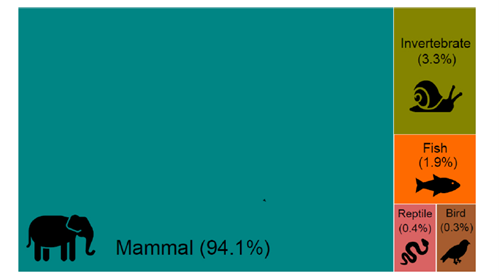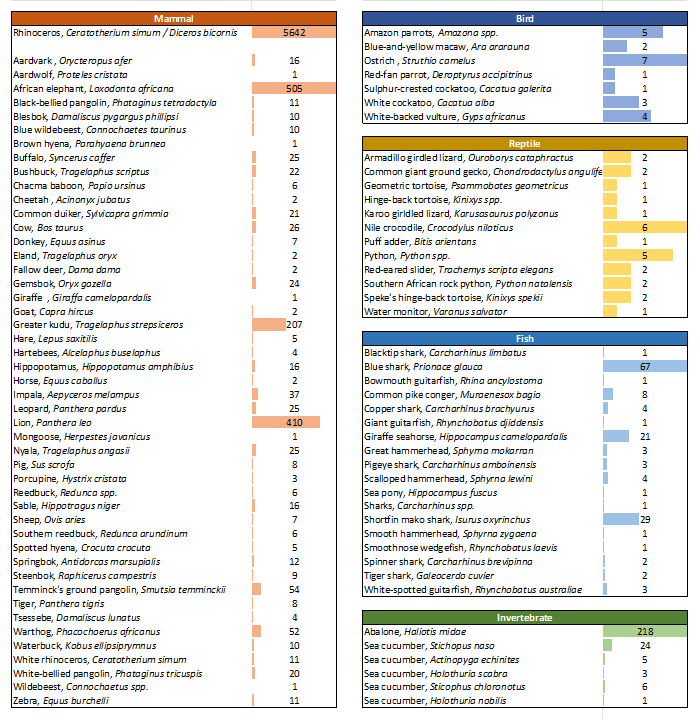Overview
Wildlife forensic science has emerged as a critical tool in biodiversity conservation and law enforcement, particularly in combatting illegal wildlife trade. In South Africa, a country renowned for its rich and diverse fauna, the need for robust forensic tools has become increasingly urgent. The illegal trade in wildlife, ranging from rhinoceros horn and elephant ivory to abalone and pangolins, poses a significant threat to national conservation efforts and undermines legal frameworks designed to protect endangered species.
In South Africa, laboratories responsible for wildlife forensic DNA analysis are contracted by local enforcement authorities (South African Police Service (SAPS) or Department of Forestry, Fisheries and the Environment (DFFE)) to provide this service based on their expertise and experience. Two laboratories within South Africa have mainly been responsible for the provision of wildlife forensic genetic analysis, namely the South African National Biodiversity Institute (SANBI) Genetic Services Unit (GSU) and the Veterinary Genetics Laboratory (VGL) of the University of Pretoria.
These facilities provide routine forensic services that support regulatory authorities and law enforcement agencies. Their work includes:
Species identification using DNA barcoding

DNA barcoding, particularly targeting the cytochrome oxidase I (COI) and cytochrome b (cytb) regions, is widely used to identify species from forensic samples. These sequences are compared against reference databases such as GenBank and BOLD. South Africa has developed curated databases through the Barcode of Wildlife Project, including 37 mammal species for COI and 23 for cytb, ensuring admissibility in court1.
Geographic origin determination

Determining the geographic origin of specimens helps trace illegal trade routes and identify poaching hotspots. This is achieved using population-specific allele frequency data and assignment testing. Case studies have successfully applied these methods to cheetah2, elephant3 and tortoise4. However, the effectiveness of geographic assignment depends on the availability of comprehensive reference databases, which remain limited for many South African species.
Individual identification

Short Tandem Repeats (STRs; otherwise known as microsatellites) and Single Nucleotide Polymorphisms (SNPs) are used to generate DNA profiles for linking evidence to individual animals. Markers for forensic cases have been validated for several species including Temminck’s ground pangolin5, several crane species6 and cheetah7. The RhODIS database for rhinoceros includes over 80 000 profiles and supports prosecutions8.
The forensic data generated is used in court proceedings and policy development, reinforcing the role of science in environmental governance.
Case review and findings
A comprehensive review of wildlife forensic cases analyzed in South Africa between August 2017 and July 2024 was recently conducted9. A total of 3 763 cases were examined, revealing significant trends in species representation and forensic demand (Figure 1):
Mammals accounted for the vast majority of cases, reflecting the high incidence of poaching and illegal trade involving species such as black and white rhinoceros, African elephant (Loxodonta africana), lion (Panthera leo), and greater kudu (Tragelaphus strepsiceros).
Invertebrate cases predominantly involved abalone (Haliotis midae), a species heavily targeted for illegal harvesting.
Fish cases had a focus on shark species due to their commercial and ecological significance.
Reptiles cases mainly focused on Nile crocodile (Crocodylus niloticus) and various python species (Python spp.).
Birds represented the fewest number of cases, and mainly involved ostrich (Struthio camelus) and white-backed vulture (Gyps africanus).

For a more indepth look at the species and their representation in the various wildlife forensic cases analysed in South Africa, refer to Figure 2 .

Geographical representation
Samples processed were predominantly from the north-eastern parts of the country, including Limpopo, Mpumalanga, and KwaZulu-Natal provinces. This regional concentration reflects both the biodiversity richness and the prevalence of wildlife crime in these areas.
Challenges and opportunities
Wildlife forensic science in South Africa has made significant strides, but several challenges continue to limit its full potential. One of the most pressing issues is the lack of resources, including funding, laboratory infrastructure, and trained personnel. Many forensic laboratories operate under constrained budgets, which affects their ability to process cases efficiently and invest in new technologies. Another major challenge is the absence of standardized protocols across institutions. Without harmonised procedures, results may vary between laboratories, which can undermine the credibility of forensic evidence in legal proceedings. Establishing national standards for sample collection, DNA analysis, and data interpretation is essential to ensure consistency and reliability. A third challenge is the limited availability of species-specific reference databases. These databases are crucial for accurate species identification, individual profiling, and geographic origin determination. However, building such databases requires extensive sampling, expert taxonomic verification, and long-term investment. For rare and endangered species, collecting sufficient reference data is particularly difficult.
Future directions
To address current limitations and build on existing successes, several strategic actions have been put forward9:
Expanding forensic capacity and infrastructure: This includes upgrading laboratory facilities, acquiring advanced equipment, and increasing staffing to handle growing case volumes.
Enhancing inter-agency collaboration: Improved coordination between conservation authorities, law enforcement, customs, and forensic scientists will streamline investigations and strengthen prosecutions. Investing in research: Continued innovation in molecular techniques such as developing new markers for species identification and refining geographic assignment methods is essential for keeping pace with evolving wildlife crime tactics.
Developing regional databases: Cross-border wildlife crime is a growing concern. Building shared genetic databases across southern Africa will support regional enforcement and facilitate international cooperation.
Summary
Wildlife forensic science has become an indispensable component of biodiversity protection and law enforcement in South Africa. Through the use of molecular tools and DNA technologies, forensic laboratories have helped solve thousands of wildlife crime cases, supported legal trade regulation, and contributed to species conservation. While challenges remain, particularly in funding, standardisation, and database development, the opportunities for growth and innovation are substantial. Continued investment, collaboration, and research will be key to safeguarding South Africa’s rich biodiversity and ensuring that wildlife crime is met with robust scientific and legal responses.
Recommended citation
De Bryun, M., Dalton, D.L., Harper, C.K., & Sethusa, M.T. 2025. Wildlife forensics in South Africa. National Biodiversity Assessment 2025. South African National Biodiversity Institute. http://nba.sanbi.org.za/.